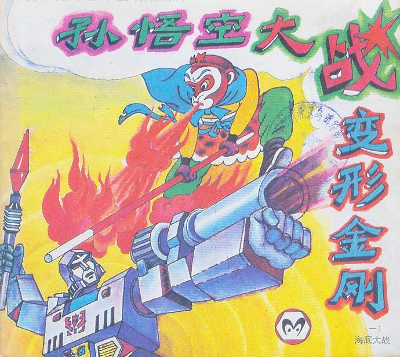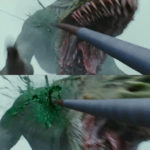I haven’t posted much on here over the past year that I’ve been at Cambridge, and in part that’s because my work (as with most first year PhDs I think) has been pretty scattered. I’ve been reading a lot, and writing a lot, but very little of what I’ve written seems particularly blog-able. I do want to share some of the stuff I’ve come across in my research into lianhuanhua 连环画 however, and also give a quick summary of where I see my work going from here. As it happens, last week I was at the Leeds Centre for New Chinese Writing sharing a very brief version of just that on a very fun panel with comrades-in-arms and fellow graduate students Shan Xiaodan, Lyu Guangzhao, and Peng Qiao. I’ve done a quick write-up of the conference , which you can read here. What follows is an expanded version of that presentation, with a brief example drawn from two of my case studies.
The question that I’ve come to over various revisions of my project is this:
How can we, from the perspective of the present, make post-Mao lianhuanhua [comic books] intelligible?
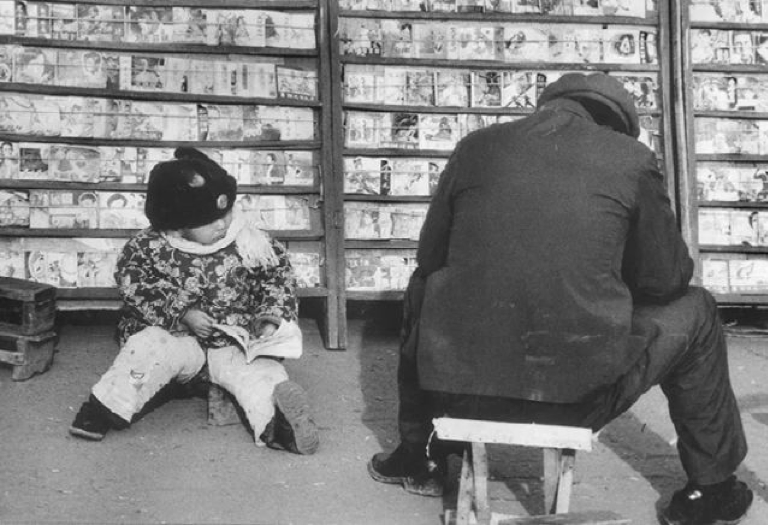
I’m using here something that Jonathan Culler once said about the work of Roland Barthes: “The critic’s job, Barthes argues, is not to discover the secret meaning of a work – the truth of the past – but to construct intelligibility for our own time [l’intelligible de notre temps].”1 Part of what I’ve been struggling with in my work is getting away from the idea that there is some sort of hidden message in the lianhuanhua that I’ve been looking at.
The working title for my thesis has also gone through several revisions, but for the moment I’ve settled on “Low Culture Fever: Chinese Comics After Mao, 1976-1983”.
As, you may have notices, I’ve referred to lianhuanhua as both “comics” and “comic books”. It’s intentional, even if it is a bit of a controversial point. I’ve also played around with adding the words, “Anxiety and Ambition in” before “Chinese Comics”. This was part of a previous revision which brought in affect theory to try to think my way out of an ideological corner I’d painted myself into. I’m still planning on using affect theory quite a bit, but after my last meeting with my committee, I’ve been rethinking how much I want to make that approach really front and center in my thesis, and how much I want to provide some alternative theoretical frameworks of my own invention.
But the real sticking point for the moment in my terminology is whether or not lianhuanhua are “comics” or “comic books”.
Lianhuanhua (or lianhuantuhua as they were known in the 1930s) is one of those subjects where it seems like everyone just comes up with their own pet term. That in itself suggests to me that we’re all making it too complicated on ourselves. Sean MacDonald, for example, has argued that lianhuantuhua really should be translated as “Comic Strips” and lianhuantuhua xiaoshuo, as “Comic Strip Novels” and while I see his point, isn’t that the latter just “comic books” by another name? Other suggestions include “picture stories”, “picture books”, and “linked picture books” (the last tongue twister being courtesy of yours truly, ca 2014).
Once again though, if the point is to make lianhuanhua from the late ‘70s and early ‘80s intelligible for people today, I would argue that best word to use is also the simplest.
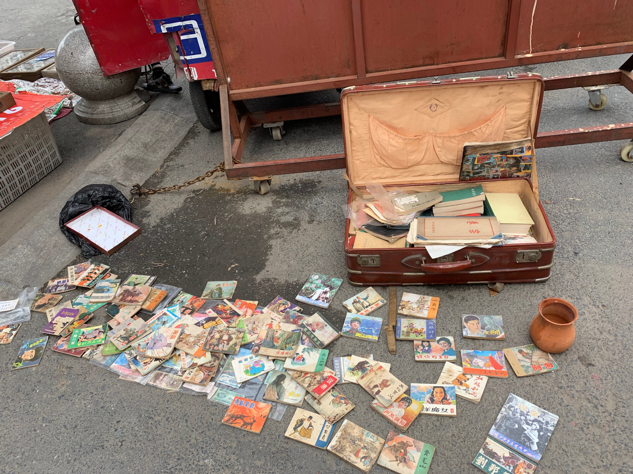
In terms of what I’m actually looking at, there are basically four parts to my research, each dealing with a different stage in the lifecycle of a “Chinese comic book”. The first is to look at everything to do with publication, from publishing houses to the distribution network, which (for the period in question) was handled by the New China Bookstore 新华书店. As far as I’ve been able to ascertain, the subject matter of lianhuanhua was decided by the editors at a publishing house, and then assigned first to an adapter, who would take an original text or film and cut it down to size, or expand it out, as the case may have been.
Adaptation then, is the second part of my research. While some lianhuanhua credit the original author as the adapters, even in those cases, I’ve only found a few lianhuanhua published in the late 1980s that are themselves “original” texts. 2
The third part of course, is illustration, which is the subject that has received the most attention from scholars and collectors in China and elsewhere to date, for perhaps obvious reasons. Since the text wasn’t “original” (in the sense of emerging fully from the imagination of the adapter) lianhuanhua scripts have mostly been overlooked. But the quality of the art and the approaches to illustration in lianhuanhua varies widely, particularly in the early Reform-era (1976-83), so-named on account of the economic and social reforms instituted by Mao’s ultimate successor, Deng Xiaoping.3
Finally, and perhaps the hardest area to find good sources on, the fourth part of my research is looking at the reception of lianhuanhua, both at the time they were published, and also in more recent decades as they have transitioned from something to be read into something to be collected.
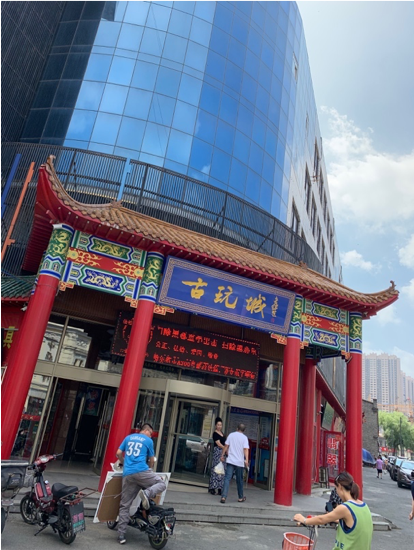
One of the things I would like to argue, though, is that people never really stopped reading, or even making lianhuanhua. Certainly, collectors probably form the largest audience today for people who are both scanning and reading scanned lianhuanhua, but even so it does a disservice to collectors (both for lianhuanhua, and American comic book fans) to think of them only being involved for the financial incentives. There are easier ways to make a buck, after all.
Over the past year, I’ve taken a couple of different approaches to writing up the research that I’ve already done on the above four topics, both by trying to sketch out all four for an individual work (as it happens, Maggie Greene’s 1980 Star Wars comic which I translated long, long ago, in a galaxy far far away) and more recently by providing an overview of one part (illustration) for a dozen lianhuanhua which were published over the entire period that I’ve proposed to look at. Neither has been entirely successful, in part because there is still a lot of work that I need to do both to really dig into my sources, and also to beat the bushes over in China to verify some of what I suspect (but cannot yet prove) was going on at the institutional level with lianhuanhua publishing, and also at the grass roots with consumption. So that’s both exciting and frustrating, which is probably a good description for graduate school in general!
For my work on illustration, I’ve sketched out the following periods based on my own (admittedly still limited) readings in lianhuanhua:
Part I: Cinematic Realism 1976-1977
Part II: Cartoon Commentary 1976-1978
Part III: Back to the Future 1978-1979
Part IV: Border Skirmishes 1978-1979
Part V: Return of the Villain 1979-1980
Part VI: A Chinese Star Wars 1980-1983
For this post, I’ll focus on the first, and perhaps return to the others for later posts if folks are curious.
I came up with the term “cinematic realism” to refer to the fact that by the mid-1970s, a number of lianhuanhua artists, particularly those working for the flagship periodical of the industry (which at the time was internal circulation 内部参考 only), Picture Stories 《连环画报》had started borrowing techniques from film to heighten the drama and realism of their work. One of the specific strategies which I have identified is extremely high or low camera angles, the former being used to depict villains, and the latter being used for heroes.
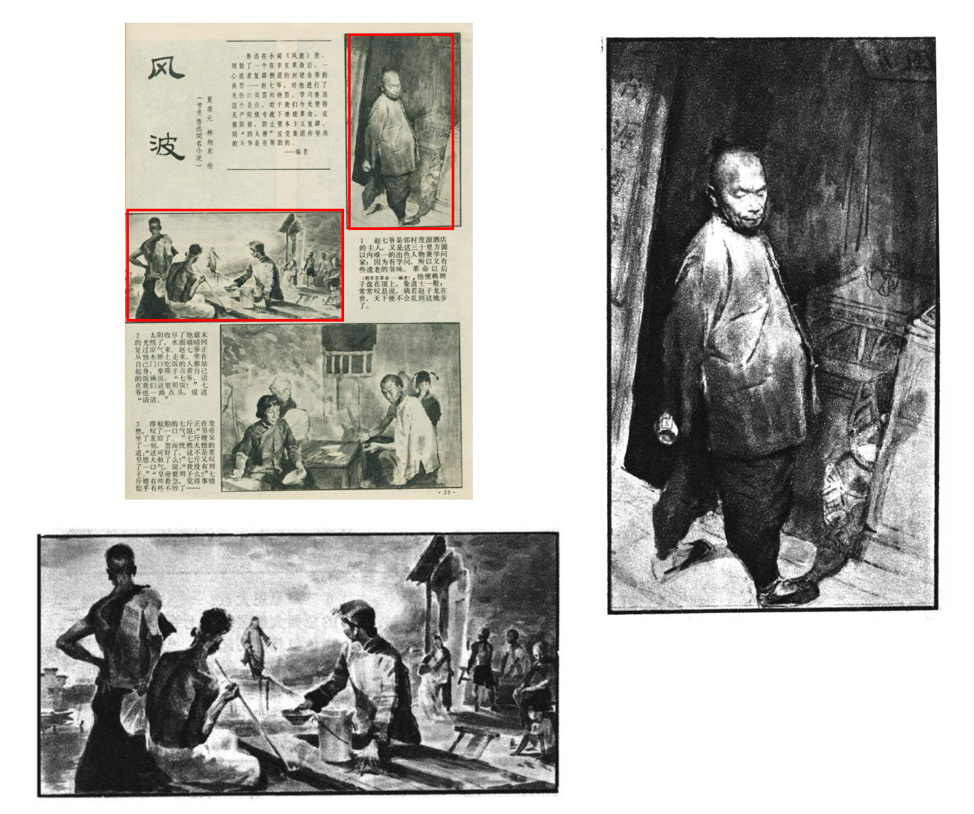
To give an example of this, check out the above story, an adaptation of Lu Xun’s short story “Tempest in a Teacup” 《风波》published in Picture Stories in the October / November 1976 double issue just two months after Mao’s death (and one month after the arrest of the Gang of Four, who are mentioned as counter-teaching examples 反面教材 in the preface).((Xia Baoyuan 夏葆元 and Lin Xudong 林旭东, “Fengbo” 风波 [Tempest in a Teacup], Lianhuanhua Bao 连环画报 [Picture Stories], no. 10–11 (November 1976).)) In the first panel, we have the villain, the corpulent Seventh Master Zhao depicted from a very high angle, with his back to the reader. For readers at the time, this would have made his role the in story clear beyond a shadow of a doubt. In contrast, the peasants of the story (second panel) are depicted from a low angle, indicating that they are meant to be interpreted as the heroes of the story. Another hint is the fact that the way Zhao is framed makes him appear much smaller than the peasants (almost mouse-like, really) despite his aforementioned girth.
During the Cultural Revolution (which officially at least ended not with Mao’s death, but with the Third Plenum of December 1978, two years later) visual depictions of heroes, whether in films or posters, were expected to be “red, shining, and bright” 红光亮 and “tall, big, and complete” 高大全. What this meant in practice was that heroes were supposed to be well-lit, and also physically imposing.4 If we look at a cover of Picture Stories from early 1976, we can see a pretty fantastic example of this:
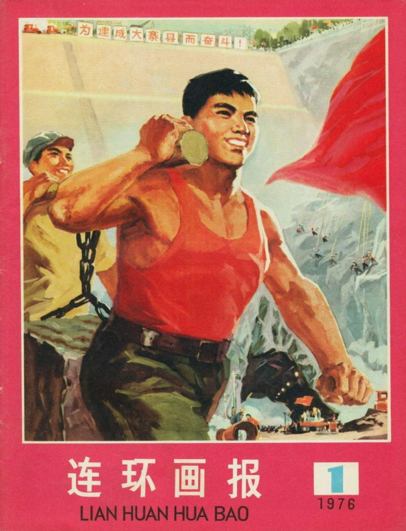
He’s even wearing red!
Lest you think I’m overstating my case here, we can see how important these sorts of visual clues were to readers if we look at second comic by the same artists as the first, published just a couple of months later in the spring of 1977. It’s also an adaptation of a Lu Xun story, this time “The True Story of Ah Q,” but retold from the perspective of the “Fake Foreign Devil” 假洋鬼子.5 Unlike their earlier work however, this comic seems to have stirred up some controversy, which the editors did their best to allay with a short piece from a “reader” who wrote in a letter (with the super subtle title “’Down with the Fake Foreign Devil’ is Great!”):
“If the ‘Gang of Four’ pattern was applied to this work by drawing the Fake Foreign Devil ashen and small, shrunken into a corner, how would you be able to see the fake foreign devil’s treacherous and deceitful, ugly mug?” 如果按“四人帮” 的框框处理, 把假洋鬼子画得又灰又小,缩在一角,假洋鬼子那幅阴险狡诈的丑恶面貌如何看得清? 6
The problem, it seems, was that it wasn’t entirely clear to all readers of the magazine who precisely the villain was in the story, and the reason for that goes right back to the time-honored, Cultural Revolution ways for depicting friend and foe. If we look at the actual comic, the problem might not be obvious at first, and again, this gets back to the problem of intelligibility that we started off with.
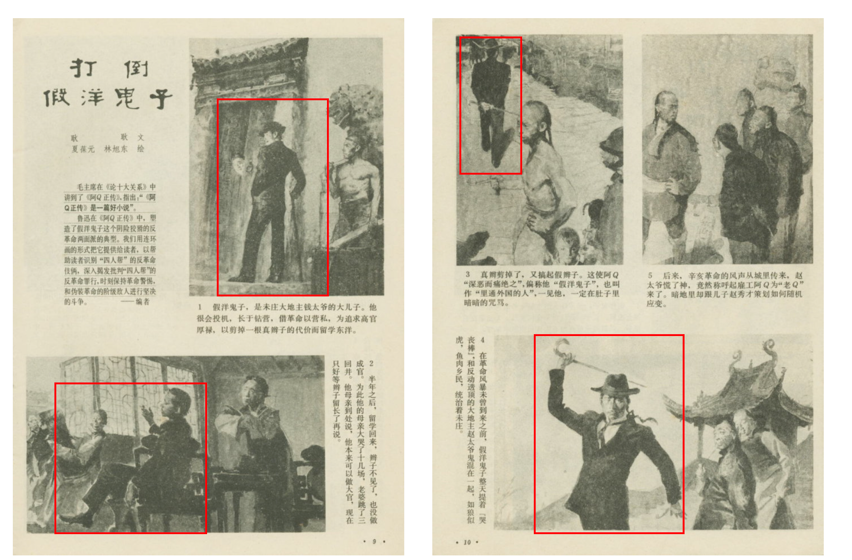
Now, for me, the first time I looked at this, I didn’t really see what the big deal was. Seems like a pretty standard, run of the mill way of telling the story (albeit with same dang cool art). But actually, if we go back to the “red, shining, bright” formula, and even more importantly for this comic (since it’s in black and white), “tall, big, and complete”, you can see that the Fake Foreign Devil (highlighted in the red squares), who is supposed to be the villain, is actually being portrayed as a sort-of anti-hero.
There is a lot of other cool stuff going on in visually in these two comics, so I do hope I get a chance to publish my work at some point so that I can share what I’ve found with a wider audience. And this is still very much a work in progress, so let me know if you see something I’ve missed or can think of some earlier examples of the “cinematic realism” trend in lianhuanhua. From my reading Picture Stories, I’m pretty sure this is one of the earliest examples of this technique (which would become quite prevalent in the magazine during the early Reform-era, with oil painting lianhuanhua becoming especially popular). But I would love to be proven wrong!
Also, as a final aside: in the process of my research, I found out that Lin Xudong (b. 1951), the younger of the two artists who worked on the two Lu Xun comics I’ve discussed, would go on to become a well-respected filmmaker, most recently editing two of Jia Zhangke’s 贾樟柯 (b. 1970) films, Ash Is the Purest White 《江湖儿女》 (2018), and Touch of Sin 《天注定》(2013). In interviews, he has talked about how his early love of film influenced his illustration work for lianhuanhua, backing up some of the conclusions I came to in my analysis, before I even knew that he was involved in filmmaking in any formal capacity. So that is pretty neat, and not at all something I expected to find.
- Jonathan Culler, Barthes (Fontana Paperbacks, 1983): 17; Roland Barthes, Critique et Vérité [Criticism and Truth] (Paris: Editions du Seuil, 1966), trans. Katrine Pilcher Keuneman (The Athlone Press, 1987): 260. [↩]
- A prominent exception is Wang Peikun’s 王培堃 wildly popular The Illustrated Adventures of the Little Elves 《小精灵画传》series, the first volume of which was published in June 1983. It is also unusual in some other ways, providing a good example of comic that is somewhere in-between manga / Euro-American comics and lianhuanhua. [↩]
- Most scholars mark the end of the early Reform-era with the Anti-Spiritual Pollution campaign 反对经省污染运动 of December 1983. See for example, Rui Kunze, “Displaced Fantasy: Pulp Science Fiction in the Early Reform Era of the People’s Republic of China,” East Asian History 41 (2017), http://www.eastasianhistory.org/41/ruikunze. [↩]
- See Adam Yuet Chau, “Political Awakening through the Magical Fruit: The Film Song of the Mango,” in Mao’s Golden Mangoes and the Cultural Revolution, ed. Alfreda Murck (Scheidegger and Spiess, 2013): 85. [↩]
- Xia Baoyuan 夏葆元 and Lin Xudong 林旭东, “Daodao jia yang guizi” 打倒假洋鬼子 [Down with the Fake Foreign Devil], Lianhuanhua Bao 连环画报 [Picture Stories], no. 3 (March 1977): 9–13. [↩]
- Ma Zhenduo 马振铎, “‘Dadao jia yang guizi’ hao!” 《打倒假洋鬼子》好![“Down with the Fake Foreign Devil” is Great!], Picture Stories, no. 6 (June 1977): 34. [↩]
